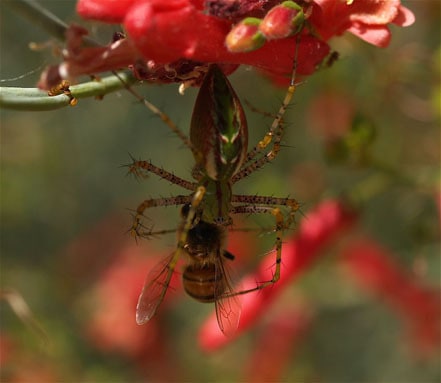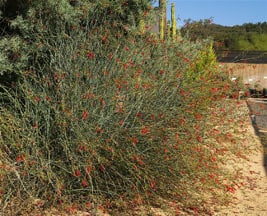 The plant is Gran Cañon Baja bush-snapdragon. It flowers all the time. Pollinators of all sorts stop by, from carpenter bees at the first hint of light before dawn, to hummingbirds stocking up on evening nectar before turning in for the night. Of course there are honeybees, many native bees, and butterflies all day. The flowers are a delight to the eyes and the pollinator activity is fascinating to see. There are times when nature will cause you to pause…
The plant is Gran Cañon Baja bush-snapdragon. It flowers all the time. Pollinators of all sorts stop by, from carpenter bees at the first hint of light before dawn, to hummingbirds stocking up on evening nectar before turning in for the night. Of course there are honeybees, many native bees, and butterflies all day. The flowers are a delight to the eyes and the pollinator activity is fascinating to see. There are times when nature will cause you to pause…
Like this green lynx spider chowing on a honey bee 8/28/08. Perfectly camouflaged, patient and agile, this species does not spin a web. It depends solely on ambush to gain advantage on its prey. The honeybee routinely goes from flower to flower and wham! the spider springs, transforming the bee into a routine meal.
There are times when nature will cause you to pause.
 “For children, nature comes in many forms. A newborn calf; a pet that lives and dies; a worn path through the woods; a fort nested in stinging nettles; a damp mysterious edge of a vacant lot — whatever shape nature takes, it offers each child an older, larger world separate from parents. Unlike television, nature does not steal time; it amplifies it. Nature offers healing for a child living in a destructive family or neighborhood. It serves a blank slate upon which a child draws a reinterprets the culture’s fantasies. Nature inspires creativity in a child by demanding visualization and the full use of the senses. Given a chance, a child will bring the confusion of the world to the woods, wash it in the creek, turn it over to see what lives on the unseen side of that confusion. Nature can frighten a child, too, and this fright serves a purpose. In nature, a child finds freedom, fantasy, and privacy: a place distant from the adult world, a separate peace.”
“For children, nature comes in many forms. A newborn calf; a pet that lives and dies; a worn path through the woods; a fort nested in stinging nettles; a damp mysterious edge of a vacant lot — whatever shape nature takes, it offers each child an older, larger world separate from parents. Unlike television, nature does not steal time; it amplifies it. Nature offers healing for a child living in a destructive family or neighborhood. It serves a blank slate upon which a child draws a reinterprets the culture’s fantasies. Nature inspires creativity in a child by demanding visualization and the full use of the senses. Given a chance, a child will bring the confusion of the world to the woods, wash it in the creek, turn it over to see what lives on the unseen side of that confusion. Nature can frighten a child, too, and this fright serves a purpose. In nature, a child finds freedom, fantasy, and privacy: a place distant from the adult world, a separate peace.”
Richard Louv
Last Child in the Woods (2005)